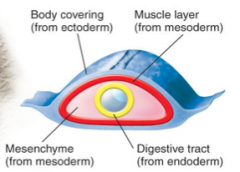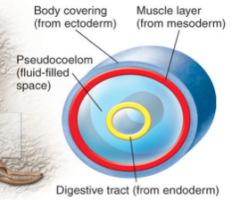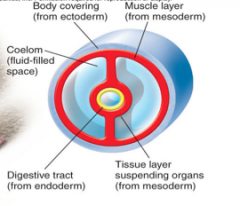![]()
![]()
![]()
Use LEFT and RIGHT arrow keys to navigate between flashcards;
Use UP and DOWN arrow keys to flip the card;
H to show hint;
A reads text to speech;
51 Cards in this Set
- Front
- Back
|
What type of symmetry do Bilatera have? |
Bilateral |
|
|
Name the 3 major groups that make up bilatera |
Acoelomates Coelomates Pseudocoelomates |
|
|
Describe the acoelomate body form |

Area filled with mesoderm cells Solid body No coelom e.g. flatworm |
|
|
Describe the pseudocoelomate body form |

Fluid filled body cavity Partially lined with tissue from mesoderm E.g. Nematode |
|
|
Describe the coelomate body form |

Fluid filled body cavity Completely lined with tissue from mesoderm e.g. earthworm |
|
|
What is the tissuue lining in coelomate (eucoelomate) animals known as? |
Peritoneum |
|
|
What are the benefits of having a body cavity? |
- Acts as cushion for organs + prevents injury - Internal organs can grow + move independently of body wall - Medium for external transport - Reservoir for waste deposition - Hydrostatic skeleton in soft bodied animals - Safe site for egg/sperm maturation |
|
|
Name the two phyla of acoelomates |
Platyhelminthes Nemertea |
|
|
How many species of Platyhelminthes are there? (acoelomates) |
>20,000 |
|
|
Describe platyhelminthes |
Flatworms Unsegmented woems Gastrovascular cavity has only one opening Gas exchange via diffusion No circulatory organs Excretion via tubular system called protinephridum |
|
|
How many classes of Platyhelminthes are there? What are they? |
4 1. Turbellaria (free living) 2. Monogena (ectoparasites) 3. Trematodes (endoparasites) 4. Cestoda (tapeworms) |
|
|
How do Turbellaria eat? |
Use mouth on mid-ventral surface |
|
|
What are the classes Monogenea and Trematoda often referred to as? |
Flukes |
|
|
What type of parasites are Monogenea? |
Mostly ectoparasites of aquatic vertibrates |
|
|
What type of parasites are Trematodes? |
Mostly endoparasites of vertibrates |
|
|
What is the common name for Cestoda? |
Flatworms |
|
|
What type of parasites are Cestoda? |
All endoparasites mostly in vertebrate digestive systems |
|
|
What is the scolex and what class has them? |
The head with suckers and hooks. Cestoda (platyhelminthes) |
|
|
What is the name of the ribbon like body in Cestoda (Platyhelminthes) called? |
Strobila made up of flattened sections called proglottids which contain reproductive organs |
|
|
How many species of Nemertea are there? Give some examples |
650 spp Ribbon worms Proboscis worms Bootlace worm - Lineus longissimus |
|
|
Describe Nemertea |
Free living, marine Flattened and cilliated most less than 20 cm but can be several mtrs Brightly coloured Long proboscis to feed on small animals Complete digestive tract with mouth and anus |
|
|
Describe the digestive system of Nemertea |
Complete with mouth and anus |
|
|
How many phyla are there in Pseudocoelomates (blastocoelomate)? What are they? |
9 - Nematoda - Rotifera - Gastrotricha - Nematomorpha - Acanthocephala - Kinorhynca -Loricifera -Prianpulida -Entoprocta |
|
|
What are the features of the Pseudo/blastocoelomates? |
Pseudocoelomates Covered in a cuticle No organs for gas exchange/excretion/internal transport Poorly cephalised Separate mouth and anus Most small, many microscopic |
|
|
How many species of Nematoda are there? |
Over 1 million |
|
|
Describe the body of nematoda |
Long, cylindrical and tapered at both ends with a thick, tough cuticle |
|
|
What role do nematoda play? |
Used in decomposition and nutrient cycling |
|
|
How do some nematoda catch their prey? |
With lassos |
|
|
Name and describe 3 parasitic (in humans) species of Nematoda |
Hookworms- e.g. Trichuris spp, Ancylostoma Necaror Young worms penetrate skin, burrow into blood stream, get carried to lungs, migrate to pharynx, swallowed and into intestine to mature Ascarids- e.g. Ascaris lumbricoides Eggs ingested through faecal contamination. Can cause malnutrition and intestinal blockage Filarial nematodes e.g. Brugia malayi, Wucheria bancroftii, Loa loa Vector borne Causes blockages in the lymphatic system. Elephantiasis |
|
|
What's helpful about Nematoda? |
They kill insects and molluscs many of which are pestiferous |
|
|
How do rotifera reproduce |
Sexual reproduction but can do asexual under favourable conditions (parthenogenesis) where growth and development of embryos occur without fertilisation. |
|
|
How did rotifera get the name "wheel bearer"? |
They have circular beat of cilla that look like turning wheels |
|
|
How many cells do rotifera contain? |
Around 1000 |
|
|
How do rotifera move? |
Swim using cilla or crawl like a leech |
|
|
What do rotifera feed on? |
Prorozoans and other rotifers |
|
|
What do Gastrotricha look like? |
Bottle shaped body Cilliated ventral surface |
|
|
How do gastrotricha move? |
Glide on surfaces propelled by their ventral cilla |
|
|
In how many days is the Gastrotricha sexually mature? What is their lifespan? |
3 days Lifespan is less than 40 days |
|
|
What do Gastrotricha feed on? |
Bacteria, protozoa and organic detrirus |
|
|
Where do Nematomorpha live? |
Freshwater |
|
|
Describe the body of Nematomorpha |
Long and hair like Up to 40 cm long |
|
|
What do Namatomorpha feed on? |
Juviniles parasitic in arthropods Adult non-feeding, free-living in damp soil or water |
|
|
What do Acanthocephala feed on? |
Endoparasites on marine, freshwater and terrestrial vertebrates' digestive systems |
|
|
Describe the body of a Acanthocephala |
Less than 5 cm long with spiny proboscis |
|
|
Describe the body of Kinorhyncha |
Microscopic. Anterior end of body is spiny to help burrow through marine sediment. |
|
|
When were Loricifera first identified? |
1983 |
|
|
Describe the body of loricifera |
Abdomen has a cuticular girdle called a lorica 0.25mm long Spiny anterior end |
|
|
Describe the body of priapulida |
Unsegmented, worm-like 1mm - 20cm long Anterior part forms introvert that can be pushed in and out Teeth at end of introvert end used to capture prey Small surface spines |
|
|
Where would you find Priapulida? |
Sediments Burrows in sand and mud |
|
|
Give an example of a Priapulida |
Priapulus cordatus |
|
|
Describe the body of endtoprocta |
Anus inside ring of tentacles Attached to rocks Grow from creeping stolon or with sponges, polychaetes and bryozoans without affecting them similar to bryozoans most colonial All less than 5mm |

